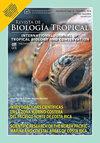卫星和历史数据,以及预测哥伦比亚太平洋海豚鱼、海斑鱼(鲈形目:斑鱼科)潜在捕鱼区的统计建模
IF 0.6
4区 生物学
Q4 BIOLOGY
引用次数: 2
摘要
引言:预测潜在捕鱼区被认为是渔业中最直接和最实用的方法之一,也是管理渔业资源决策的一项重要技术。它帮助渔民降低燃料成本和捕鱼量的不确定性;这项技术有助于国家和国际粮食安全。在这项研究中,我们建立了预测统计模型的不同组合,如广义线性模型和广义加性模型。目的:预测海豚鱼(Coryphaena hippurus L.)PFZ在哥伦比亚太平洋的空间分布。方法:我们建立了广义线性模型和广义加性模型的不同组合,以预测2002年至2015年捕获的马齿苋的单位努力渔获量与海面温度、叶绿素a浓度、海平面异常和水深的关系。结果:具有高斯误差分布的广义加性模型在预测海龙PFZs方面获得了最佳性能。通过交叉验证方法计算均方根误差进行模型验证。该模型的R2为50%,这被认为适合所使用的数据类型。1月和3月是单位努力捕获量值最高的月份,而11月和12月的值较低。结论:广义加性模型预测的马齿苋PFZ与前人的研究结果一致,表明我们的模型可以作为哥伦比亚太平洋马齿苋物种评估、决策和可持续利用的工具。本文章由计算机程序翻译,如有差异,请以英文原文为准。
Satellite and historical data, and statistical modeling to predict potential fishing zones for dolphinfish, Coryphaena hippurus (Perciformes: Coryphaenidae) in Colombian Pacific
Introduction: The prediction of potential fishing areas is considered one of the most immediate and practical approaches in fisheries and is an essential technique for decision-making in managing fishery resources. It helps fishermen reduce their fuel costs and the uncertainty of their fish catches; this technique allows to contribute to national and international food security. In this study, we build different combinations of predictive statistical models such as Generalized Linear Models and Generalized Additive Models. Objective: To predict the spatial distribution of PFZs of the dolphinfish (Coryphaena hippurus L.) in the Colombian Pacific Ocean. Methods: We built different combinations of Generalized Linear Models and Generalized Additive Models to predict the Catch Per Unit Effort of C. hippurus captured from 2002 to 2015 as a function of sea surface temperature, chlorophyll-a concentration, sea level anomaly, and bathymetry. Results: A Generalized Additive Model with Gaussian error distribution obtained the best performance for predicting PFZs for C. hipurus. Model validation was performed by calculating the Root Mean Square Error through a cross-validation approach. The R2 of this model was 50 %, which was considered suitable for the type of data used. January and March were the months with the highest Catch per Unit Effort values, while November and December showed the lower values. Conclusion: The predicted PFZs of C. hippurus with Generalized Additive Models satisfactorily with the results of previous research, suggesting that our model can be explored as a tool for the assessment, decision making, and sustainable use of this species in the Colombian Pacific Ocean.
求助全文
通过发布文献求助,成功后即可免费获取论文全文。
去求助
来源期刊

Revista De Biologia Tropical
生物-生物学
CiteScore
1.80
自引率
0.00%
发文量
23
审稿时长
4-8 weeks
期刊介绍:
The Revista de Biología Tropical / International Journal of Tropical Biology and Conservation is a mainstream scientific journal published since 1953 and covered by Web of Science; Science Citation Index; Current Contents; Google Scholar; Scopus, SciELO and nearly 50 additional indices.
A double blind system guarantees you a fair evaluation, and our world class editorial and scientific boards provides a first decision in three working days. The journal is Full Open Access and is widely read where your article can have the highest real impact.
Since its beginning in 1953, the Revista follows these principles: objective and independent evaluation of all manuscripts; transparency in all processes; ethical use of procedures, data, specimens and subjects; fair treatment of all parties; and absolute predominance of scientific rigor over any other aspect.
 求助内容:
求助内容: 应助结果提醒方式:
应助结果提醒方式:


